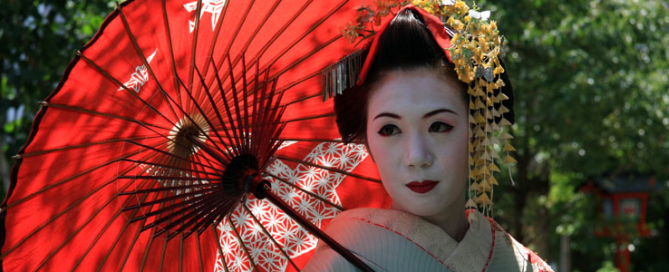Japan – 81,630 Km
I arrived to Japan by boat from Shanghai, China. I disembarked in Osaka, an important city located in the Kinki region on Honshu Island. According people explained to me Japan consists of four main islands, Honshu, Hokkaido, Kyushu and Shikoku, which form 97% of the total land area, and more than 6,000 smaller islands adjacent.
When I arrived to Osaka I cycled toward the city center and as I approached I was surprised increasingly by its silence. I did not even hear the engine of cars. Although I was in a city of more than 2 million people I had the feeling that I was in a village.
Then I met Daisuke, a Japanese guy who traveled around the world by bike for 11 years. “Now my life has become monotonous”, he said to me, “I miss the uncertainty of the journey”. I kept silence; I was pensive and for a few seconds I thought about the end of the trip. Daisuke was right.
After visiting the Osaka Castle, Daisuke took me to his friend’s house Shuji, where I stayed for one night. “It is better”, he said to me, “because since my arrival I often take people to my parent’s house. And according to local custom, the Japanese are not accustomed to hosting people in their homes”. And I realized, because none received me in spite of all the contacts that I had through the country. Or even worse, some people replied me when I had already left the country. That night together to Daisuke and Shuji, we had Japanese-style dinner, we talked about our journeys and they gave me all the info and maps to travel through Japan. They were the only ones who welcomed me and with whom I shared a table.

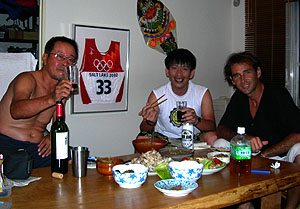
Neither I met foreigners who welcomed me into their homes, as if they also be ruled by local traditions. As I use to do, in expensive countries I request accommodation to foreigners or local people through a traveler – site, especially in big cities or capital cities. But in Tokyo I was not lucky, because the only one guy who offered me to stay at his house was a Spanish guy who preferred called himself Medium. But he told me that he practice nudism and preferred that their guests are naked at home; and that he also was bisexual and he liked me. So I did not hesitate, every night during my stay in Tokyo I set my tent in the cemetery; I preferred to sleep with the dead than such gay.
Anyway, Japan is a wonderful country to travel by bicycle, is neat, clean, safe and with some impressive forests, rivers, mountains, countless temples and beaches with fabulous sunsets that have little to envy. No doubt Japan will be on the list of most beautiful countries I visited.
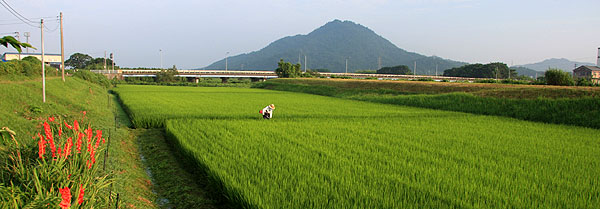
My first destination was Nara, one of the most important tourist destinations of the country due to the large number of ancient temples and their preservation. The temples which are part of the UNESCO World Heritage are mainly located in Nara Park, which is a deer park too, with streams and all the perfect tranquility for camping; although it is forbidden, but if you arrive at night….
Then I keep cycling to Kyoto, the city which is considered the Japan Cultural Center. Their historical monuments were also declared World Heritage by UNESCO. But they are a lot to visit, and after three or four, all look the same or even worse, just a place to spend money. This is what I thought about the Kinkaku-ji Temple, the postcard from the city, also known as the Golden Temple. Kinkaku-ji Temple is a Zen temple dating from the XIV century and it is believed that it preserves relics of Buddha. After paying the ticket the visit involve just walking among trees along a path of 150 mt around the temple, and then guided by security guy people crowd together in a corner to take photos. You can not enter to the temple, even approach it. Then, there are three rest stops, one to buy souvenirs, another for drinks and the last one to buy ice cream. It is a shame! I felt like a fool to have entered there. I don’t know why in some places I still do what all the tourists do.

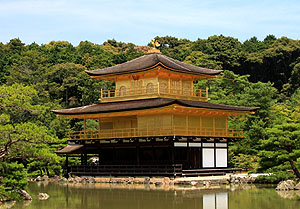
But in Kyoto I found more interesting to walk the streets, where fortunately I met two Geishas. As people explained to me, the geisha were originated as entertainment professionals. During the XVIII and XIX centuries were quite common but today the number of Geishas has reduced. They were usually educated from childhood in various arts such as dance, classical music, or narration. Today young women who wish to become geisha began their training (which can last up to some years) after completing high school or even after college. Thereby, they live in traditional geisha houses and study instruments such as the bamboo flute and drums, and traditional songs, Japanese dance, tea ceremony, literature and poetry Japan. The geishas are characterized by their traditional makeup consisting of a thick white paint base upon which emphasizes the use of red lipstick and black trimmings around the eyes and eyebrows. Also they always use a kimono and hairstyle bun or wigs. According to Takahiro geishas are often hired to attend parties and gatherings, traditionally at tea houses or in traditional Japanese restaurants. Its role he said to me: “The deal with customers”.
Way to Tokyo I crossed through the cities of Nagoya, Shizuoka, Yokohama, among others. I often camped in temples, which are empty and have bath or just a tap; thereby they were the perfect place to camp. Usually I arrived with the last light of day, set the tent, took a quick shower and I cooked. In the morning after another quick shower and a good breakfast I started to cycle. Almost always everything was perfect. But one morning in a temple, where some people live, I woke up with my tent flooded, it had rained the whole night, and at 6 am I had to get up and move to a shelter at the entrance of the temple. That day rained incessantly, and strong. Through the hours people of the temple noticed my situation, but they never approached me and asked me if I needed anything. On the afternoon, I was hungry and despite the rain I went to a supermarket which was 6 km away, then I came back and cooked; and I spent another night there, but due to the tent was still wet I slept on a bench. In the morning while I was packing my staff one of the people from the temple came to me and asked me if I needed something, and although I said I was ok, he brought me a sandwich. And I accepted it, although I would have preferred that he has invited me but the day before. I had the feeling that, that’s the way of Japanese and another Asian people. They are quite tough to give a hand. They are different to the Arabs.
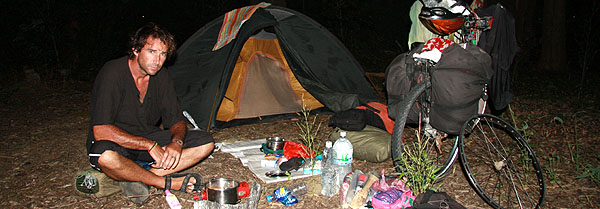
Several times I was lost on the road, thereby I came close to the cars with my map on hands and I asked for information, but it was difficult to find someone who assisted me.
Many of people who I asked not even rolled down the window. Perhaps because they don’t speak English, maybe because of fear, shyness or just because the air condition was on. I do not know, but I wanted to break their windows with a punch, I felt powerlessness and therefore I cursed them. I remember one day an elderly couple walked toward me while I looked at my map; so I asked to the man about my route. The man was kind, he stopped and tried to assist me, but his wife immediately took him by the arm and took him away. I could hardly believe it.
Tokyo
Japan has a population of more than 120 million people, the tenth largest in the world. The Tokyo metropolitan area, which includes the capital city of Tokyo and its surrounding municipalities, is the largest urban area in the world in terms of population, housing more than 30 million people; thereby I thought to arrive to Tokyo would be an ordeal. But on the way I met Riku, who was also cycling to the capital city, so everything became easier.
On our arrival we met Shinosuke, a Japanese boy who had traveled U.S. by bike for 4 months, and after talking a while he suggested to camp in the cemetery. That night, Riku who had place to stay, accompanied me to the cemetery and then he left. The cemetery was huge and open; it had baths, some trees and enough space between the graves to set the tent. It was the perfect place to camp. I spent 4 nights, I used to arrive late and leave early, and nobody ever bothered me. But more than once I had to get up due to strange noises.
During my stay in Tokyo I visited several places of the city, like Asakusa where I visited the Sensoji Temple and the shopping areas as Sinjuku, Shibuya and Ginza. Then I went to Odaiba, the Tokyo Tower, the fish market and the Sumo Museum. Wanting to have a new experience, one afternoon I went to a “Capsule hotel” in which their rooms are like a box (2 x 1 x 1 mt), they are stacked side by side and two units top to bottom, type niche. But I liked it, these rooms have TV, and they are the cheapest accommodation in the big cities, always located near train stations. The price of the room of the hotel, which has also sauna, is about 15 euros for about 6 hours in the afternoon, and to spend a night is over 35.
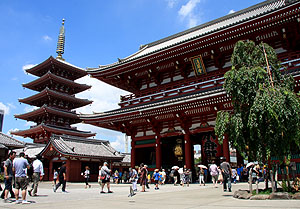

During my stay in the capital city I contacted a cycling magazine to sell them an article about my trip, but I found very difficult to negotiate with them, and although Japan is the second largest economy and one of the most expensive countries in the world they paid my article as one of the poorest country. And I accepted it, because since I arrived to East Asian countries, more than one year ago, I couldn’t get any sponsor. That’s why; I also stopped in different shopping areas, as I did in Europe, to sell my photos and souvenirs. But as in other Asian cities I found difficult to raise money with people in the street.
I left Tokyo by boat, towards Shikoku Island. Then I started to cycle from Tokushima till Imabari along the coast, where beaches with fabulous sunsets welcomed me to camp. Then on my way to Hiroshima from Shikoku Island I crossed to Honshu Island through bridges which connect different islands like Oshima, Hakata and Innoshima among others. This last stretch through the islands is 70 km and it is the favorite circuit for many Japanese families for cycling; it has a bike path, campgrounds and beaches which are worth a stop. Definitely it is a wonderful place to visit.
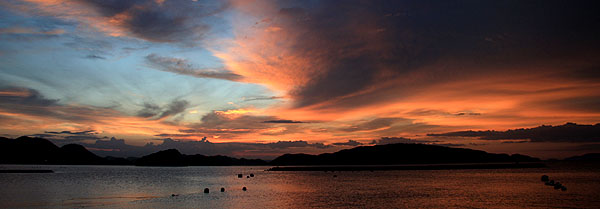
My last stop was Hiroshima city, the scene of the first atomic bomb in the history, occurred on August 6, 1945. There the Peace Memorial Museum, exhibits memorabilia of the incidents and stories of experiences of the victims, and not only explains in detail the disaster but also displays information on atomic weapons in the world.
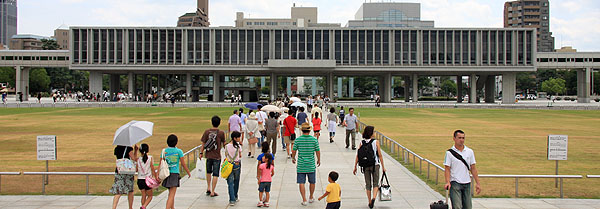
It is estimated that the Hiroshima atomic bomb killed about 140,000 people, almost all civilians, leaving more than 250,000 injured. The victims, from 15 to 20% died from injuries or illness attributed to radiation poisoning. And it is said that the biological and anatomical mishaps persist in the Japanese population currently.[:]


